January Games
Happy 2024! I’m going to try something new here that I haven’t done before, and give a brief recap/review of the games and media I’ve been playing over the past month. Also, if I continue doing this, I guarantee that most of them won’t be as long as this one. I don’t usually beat this many games in a month.
Snakebird Complete #
Technically, this was right on the border between last year and this year, but whatever. This was one of the free games from Epic. (It’s always nice when Epic gives away a game you’re already interested in). I completed all of Snakebird Primer. It’s a fun puzzle game where you have to move the snakebird into the goal.
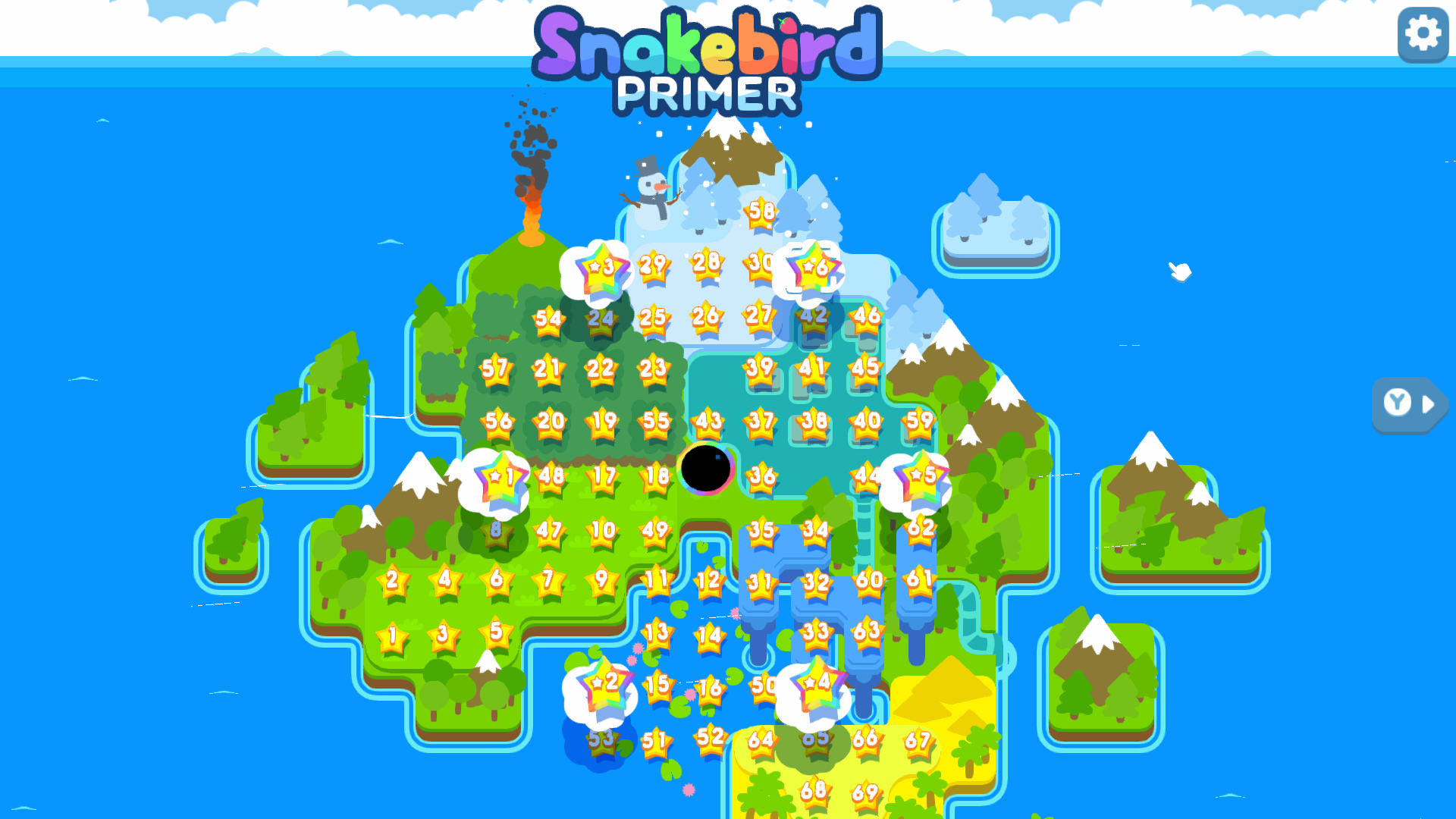
The snakebird moves like a snake, as you might expect, and grows whenever it eats a fruit. Unlike snake, which is top down, Snakebird is a side view, so the snakebird will fall if none of its body is supported on ground.
I think the puzzles in Snakebird Primer are very fun, and I think the difficulty is reasonable, too. Some of the later puzzles (especially the final puzzle in the center of the map) are pretty difficult and gave me a bit of trouble. None of the puzzles in the game seemed unreasonable. However, the Snakebird Primer puzzles are a lot easier than the original Snakebird puzzles. I’m only about 10 levels into Snakebird right now. I definitely understand why Snakebird Primer is shown first in the collection, even though it’s a sequel. Because of the difficulty, I think Snakebird Primer is a much better starting point for the game.
Neon White #
The first game I’ve played this year is Neon White. It’s a really fun game! It’s a first person shooter with short, fast paced levels. Every level is a time trial to clear all the enemies and make it to the goal as quickly as possible. It is really fun to optimize the levels, trying to get a better time!
One of the characters, Neon Yellow, is played by Ian Jones-Quartey. That was a nice surprise.
Portal: Revolution #
Portal: Revolution was an incredible Portal mod. I thought the puzzles were fun and the writing and voice acting were funny. It included a lot of funny references to other Portal mods (such as Portal Stories: Mel, and I think at one point The Office Prank. Or maybe those mannequins had nothing to do with The Office Prank.) The game also includes a bunch of quality of life improvements that I really liked (such as the Portal 1 style crosshair[1], and lasers don’t burn or push you which makes laser puzzles nicer to do.
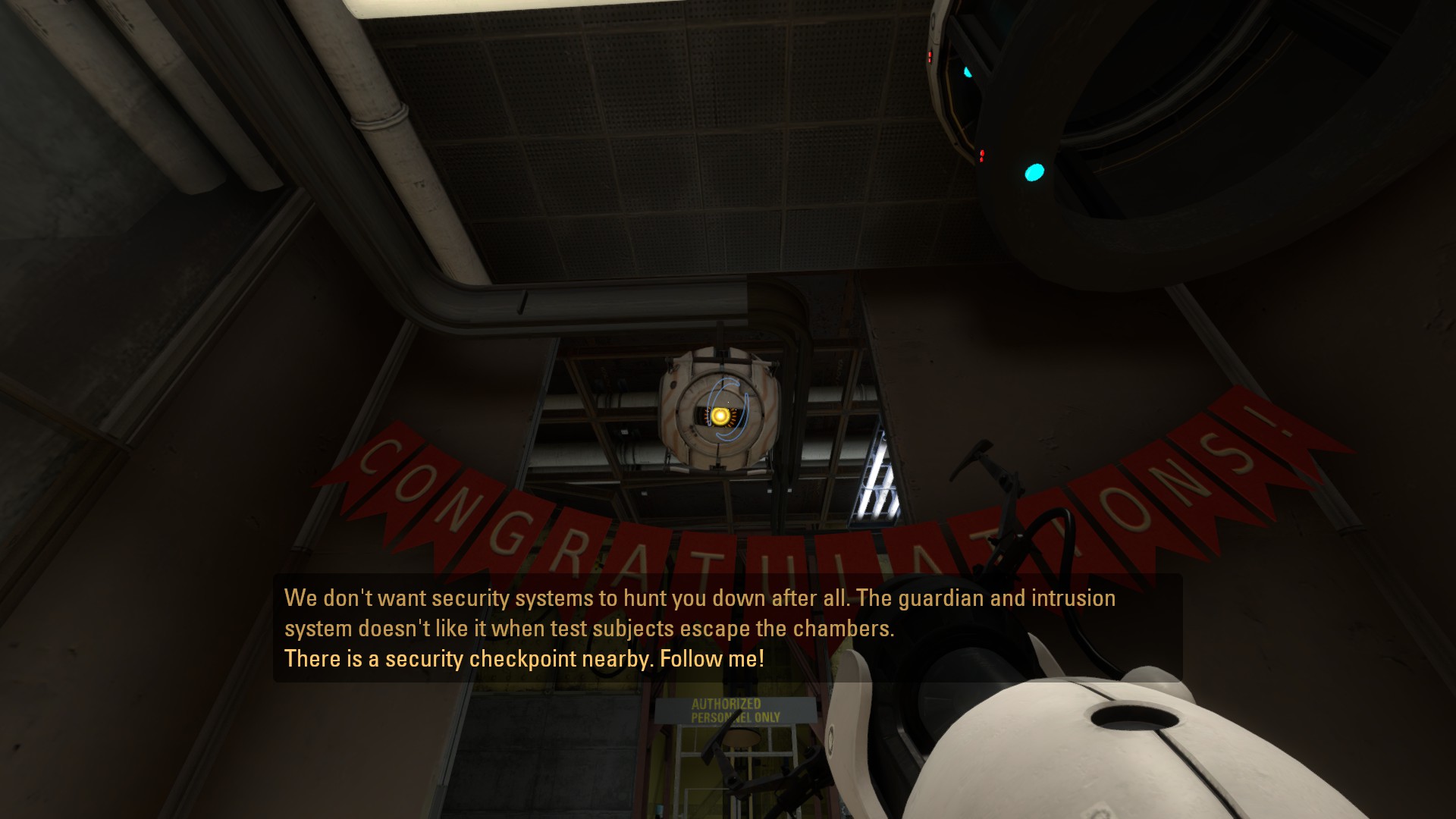
This is referencing the Aperture Employee Guardian and Intrusion System (AEGIS), the main antagonist of Portal Stories Mel.
Portal: Revolution doesn’t really add that much in terms of new mechanics. There’s the power lever (such as in chamber 14), which turns off the power (fizzlers, dispensers, doors, etc.) for the chamber until you turn it back on. The other notable new mechanic is the teleport laser cube, which was honestly incredible. One little level design thing that I really appreciated was the use of Portal 2’s most powerful untaught mechanic. There were a couple points in the earlier puzzles that were tricky, until I remembered that YouTube video.
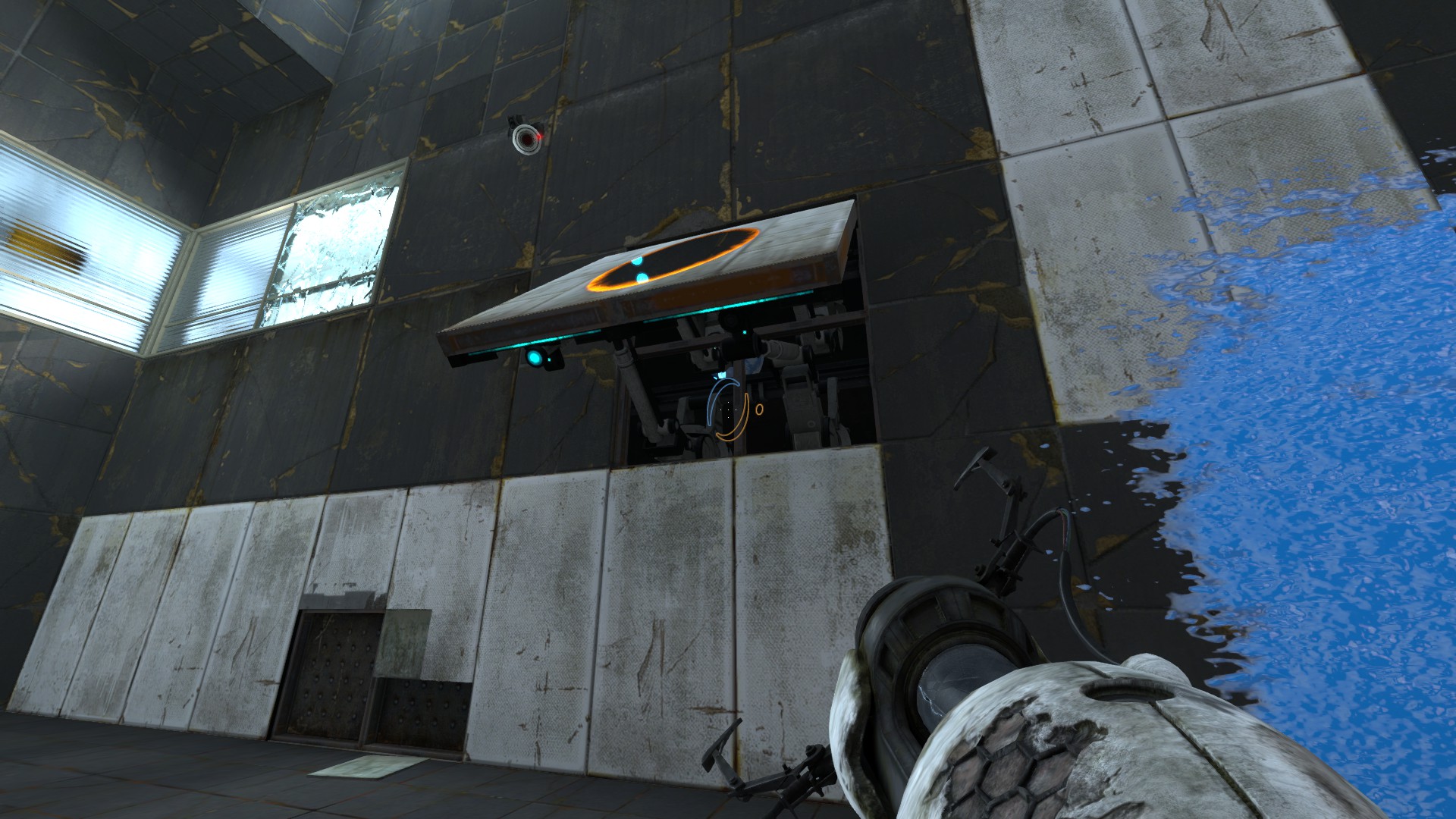
The only puzzle I thought was really difficult was chapter 4 chamber 14. Presumably other people also thought so, considering my YouTube video showing my solution has 6.4k views lol.
Portal: Forbidden Testing Tracks #
Portal: Forbidden Testing Tracks is a doozy. It came out before Revolution, but I didn’t play it until after. I was going to play it when it first came out, but I held off because I saw it was getting negative reviews. (Honestly, of the ones I had on my wishlist, the only one I expected to be bad was Portal: Crossover, but that one’s been de-listed from Steam). But after I finished Portal Revolution, I was still in a Portal mood, so I might as well play it.
The first thing I noticed when I launched it was that there is no linux version. The store page says there’s a linux version, but there just isn’t one. If you look at PFT on SteamDB, you can see that it’s marked as supporting linux, but there just isn’t a linux depot. If you’ve never encountered this before (and you probably haven’t), if a game says it supports linux but there’s no linux version, then it will just install an empty folder and say “no executable found” when you try to launch it.
Broken linux versions of games happen from time to time, and usually it’s not that big of a deal to fix it. Usually, you either just set the game to use proton (like what I did to fix Prime Mover’s broken linux version), or sometimes there’s a fix you can do to get it working natively (like what you have to do with Aperture Tag’s broken linux version). But when I tried to launch it under proton, it also failed to launch![2]
Luckily, the fix for Aperture Tag also works here (mostly). I wasn’t able to use the exact trick that fixes Aperture Tag, but it’s basically the same. I copied PFT’s files into the Portal 2 installation folder, and launched Portal 2 with the -game pft argument. This works, but there are some downsides. The menu doesn’t work with this (instead it shows the normal Portal 2 extras menu)[3], and there are some missing textures and models. These seem to be caused by the way I’m launching it, because these textures and models are present in other people’s footage of the game. I’m sure I could get it working all the way if I kept messing with it, but it’s honestly not worth it. So the game is a little more broken for me than it is for other people.
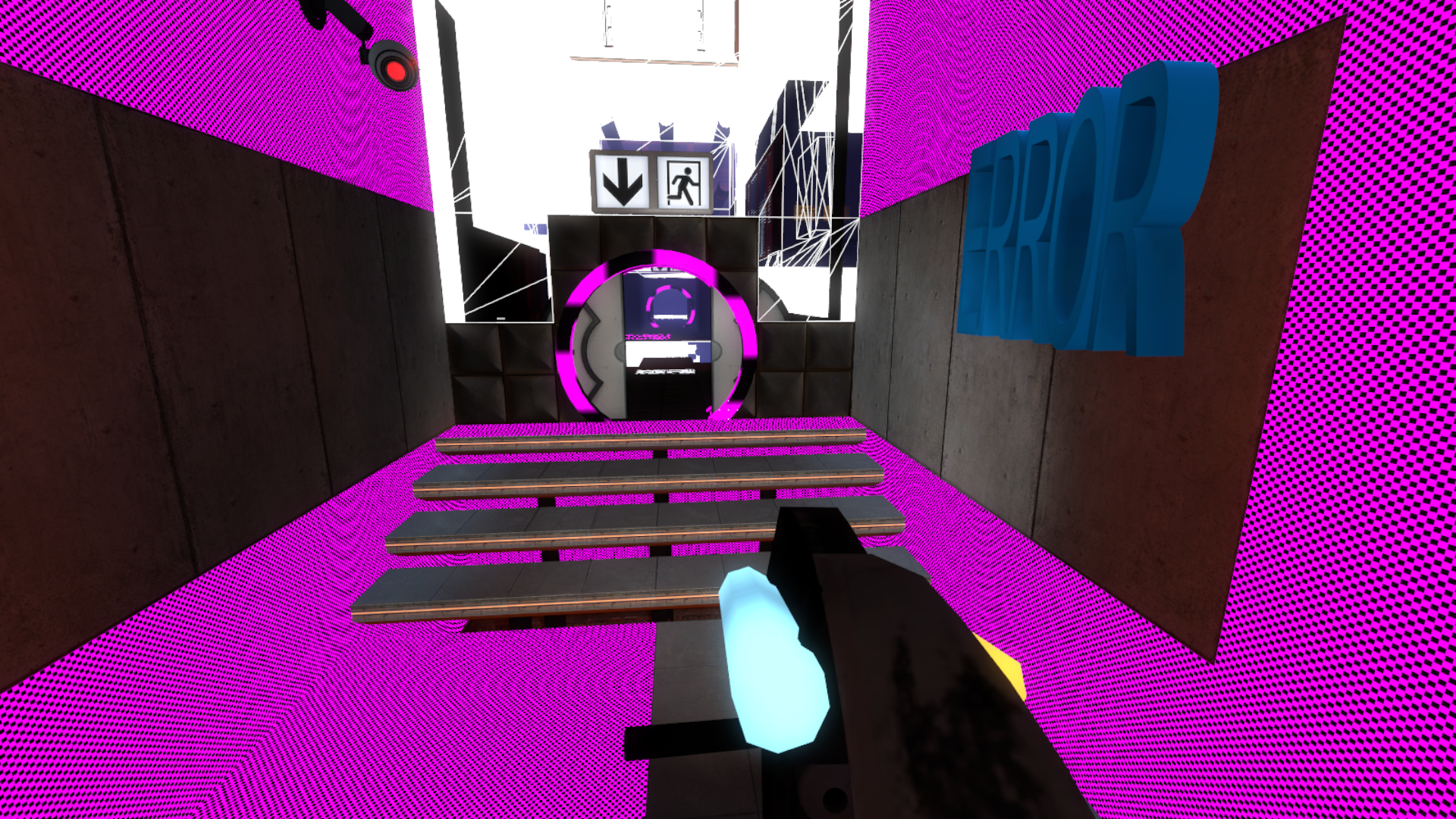
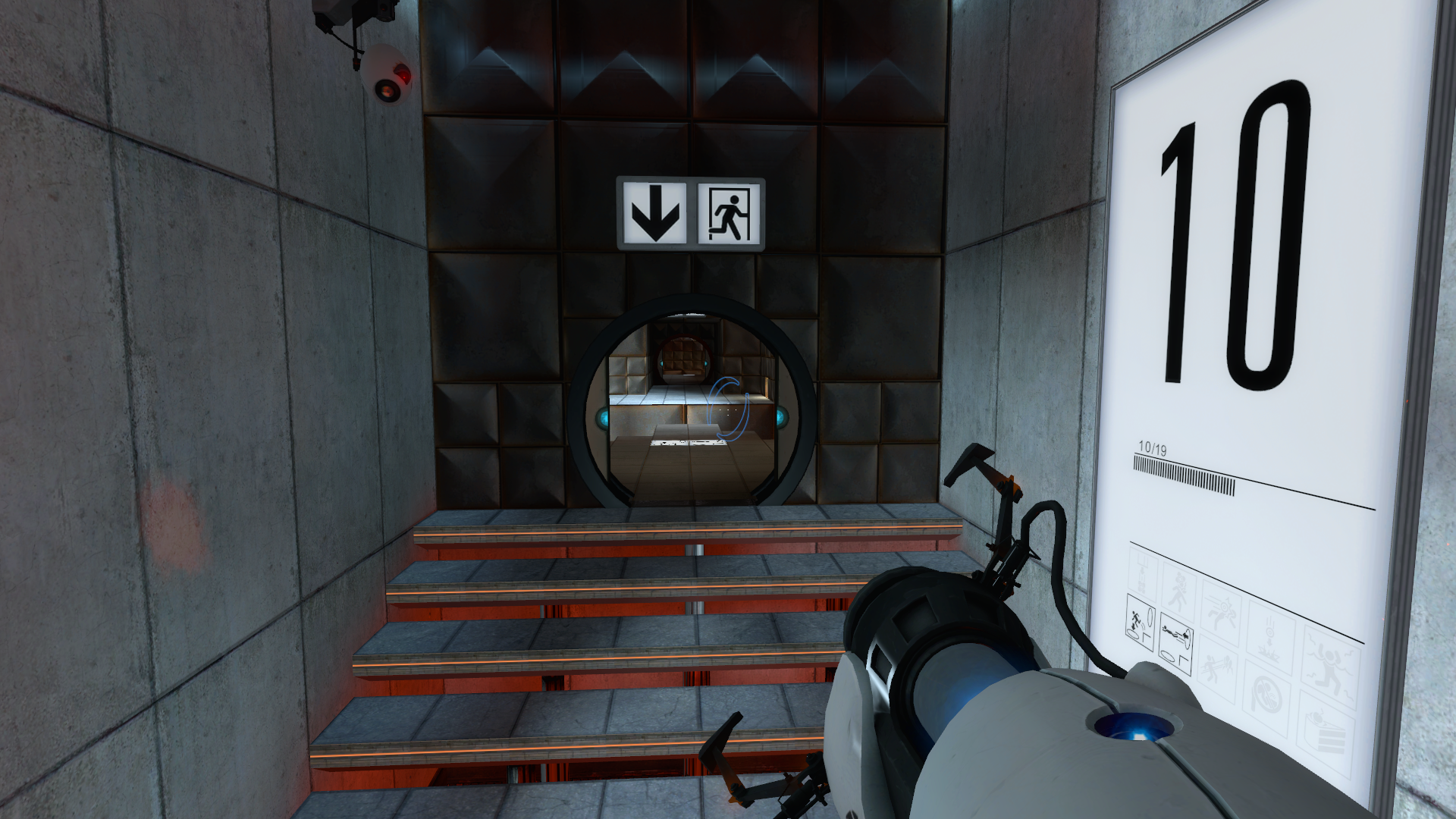
Now that I’ve gone over the trouble I had getting the game to launch, I can talk about what the game is actually like. And, it’s weird. I don’t think it’s terrible; there are definitely good ideas here! But it’s definitely not polished, and many of the design choices leave me confused. For example, at one point there’s an escherian stairwell that seemingly loops forever, but once you go up it about 20 times (I don’t have the exact count) a path opens up. In another level there’s a giant maze! On one level, the entire map is constantly spinning. Many of the puzzles have unlabeled elements, making it difficult to tell at a glance what any given button will do, and sometimes even pressing it doesn’t make it obvious what it does! Many levels in this game make me feel like the developer doesn’t want want them to be played.
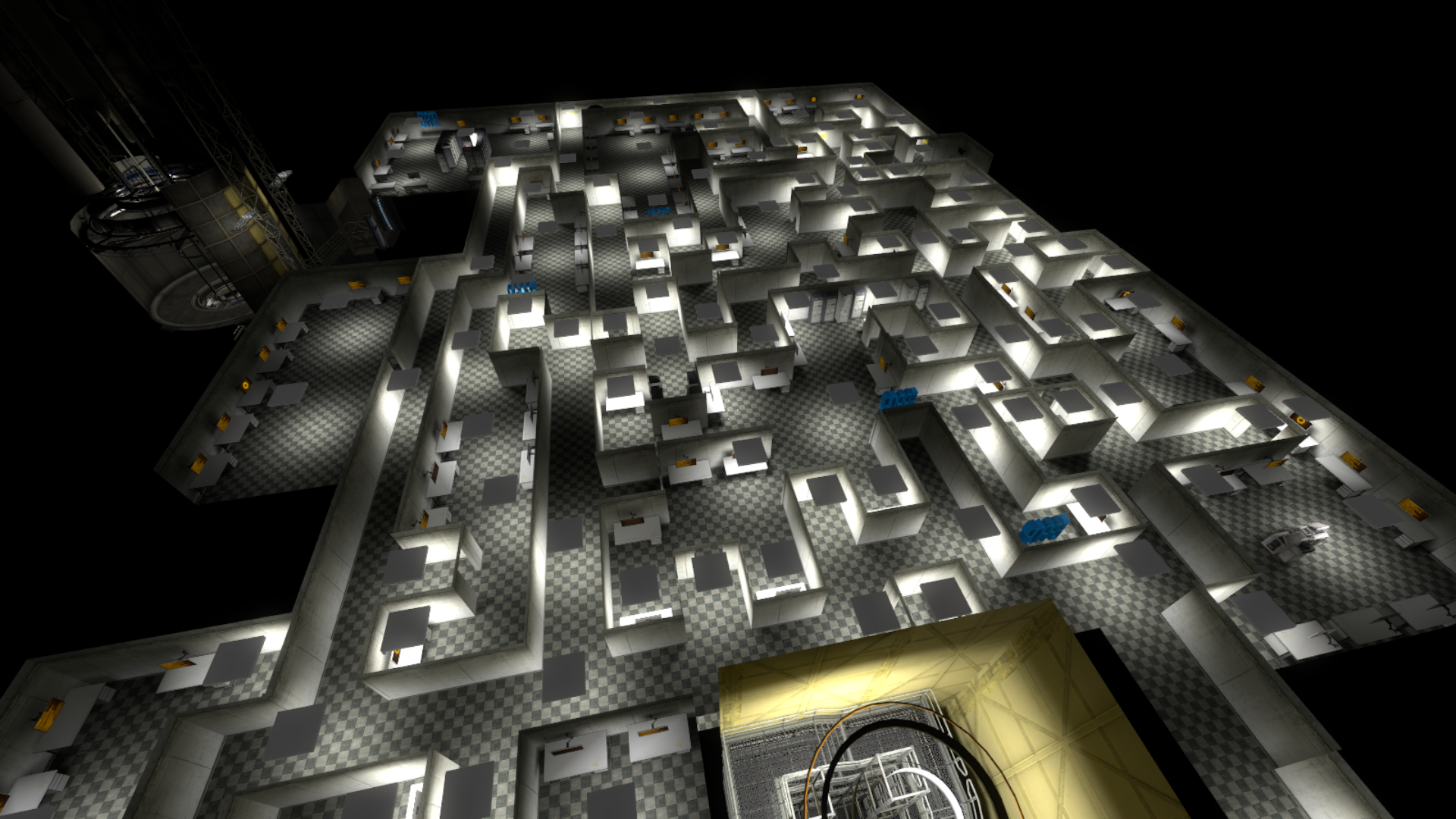
The game suffers from a lot of the problems you would expect: bad puzzle design, odd stylistic choices, AI generated voices[4]. One of the game’s gimmicks is to use mechanics inspired by other games and portal mods. For example, the paint gun from Aperture Tag, the gravity gun from Half-Life 2, and a couple other custom guns. While you can make good puzzles with these mechanics (Aperture Tag obviously has a lot of puzzles with the paint gun, and Blue Portals has some puzzles that I think use the gravity gun well), these mechanics are under-utilized in PFT.
There is one puzzle I thought was pretty good that I want to highlight. It was a puzzle utilizing the “electro catapult” (reskinned faith plate). It involved bouncing over a room of spikes, and hitting buttons on the ceiling while flying over the spikes. It was a pretty well made puzzle. Not fantastic, but decent. It still had its issues (including a mystery button of unknown purpose that wasn’t required for the solution), but I think it was fun. If the whole game was of that quality, it still wouldn’t be great, but I think I would’ve enjoyed it.
(I made a video of me exploring the back half of PFT. When I saw the spinning map, I figured that I wanted to start recording. The video is just me skimming through several of the later maps. It’s probably not that interesting to watch, but I put it here if you do want to see it.)
Ghost Trick #
Ghost trick has been on my radar for a while. I had heard that it’s similar to Ace Attorney, especially with it being written by Shu Takumi. The Ace Attorney comparison definitely makes a lot of sense, especially in terms of writing, but the gameplay is pretty different.
The story follows Sissel, who recently died and is trying to recover his lost memories and solve the mystery behind his own death. You have two buttons: Ghost and Trick. The ghost button lets you move around and possess objects, and the trick button lets you manipulate the object you’re possessing. The control scheme might be simple, but the game utilizes it well, there’s never a point where I felt like it’s too limiting.
AI: The Somnium Files #
I actually started playing AI: The Somnium Files back in 2022, but I didn’t finish it until now. A bit part of the reason I put it off so much is because of the gross eye images (and there are a lot of them in this game).
You play as Kaname Date, a detective working at a secret police organization called ABIS. ABIS uses a top secret tool for their investigations: a Psync machine. The Psync machine allows you to enter a persons dreams, which they use to gather more information from suspects. The legality of this is… Questionable. (That’s why it’s top secret!  ) Date is investigating the murder of Shoko Nadami, who was found killed with her left eye mysteriously removed.
) Date is investigating the murder of Shoko Nadami, who was found killed with her left eye mysteriously removed.
Date’s left eye is also mysteriously missing, as are all his memories from before 6 years ago. (I’m sure it’s not related at all…  ) Luckily, in place of an eyeball, he has something better: an AI ball (Do you get it? This game has a lot of jokes that only work if you pronounce “AI” as “eye”.) named Aiba. I think it’s a really funny concept, that Date has an assistant that lives inside his head (literally) that he’s constantly bantering with, but most other people don’t know about her.
) Luckily, in place of an eyeball, he has something better: an AI ball (Do you get it? This game has a lot of jokes that only work if you pronounce “AI” as “eye”.) named Aiba. I think it’s a really funny concept, that Date has an assistant that lives inside his head (literally) that he’s constantly bantering with, but most other people don’t know about her.
AI: The Somnium Files Spoilers
I really liked some of the later twists in the story. The Psync machine is revealed to have a secret use, beyond allowing you to enter people’s dreams. If you stay in somnium for more than 6 minutes, you can swap bodies with someone! This twist does a really good job of tying up most of the loose ends of the story. Throughout the different endings, there were a few suspects, and nothing that really points to one specific person. But with the body swapping, this makes sense: the same person was doing all the killings, but was using a different body every time!
CW: drawing of dead body, AI: The Somnium Files Spoilers, Zero Escape Spoilers
Here’s a reference to Zero Escape I found in that game that I thought was pretty neat!
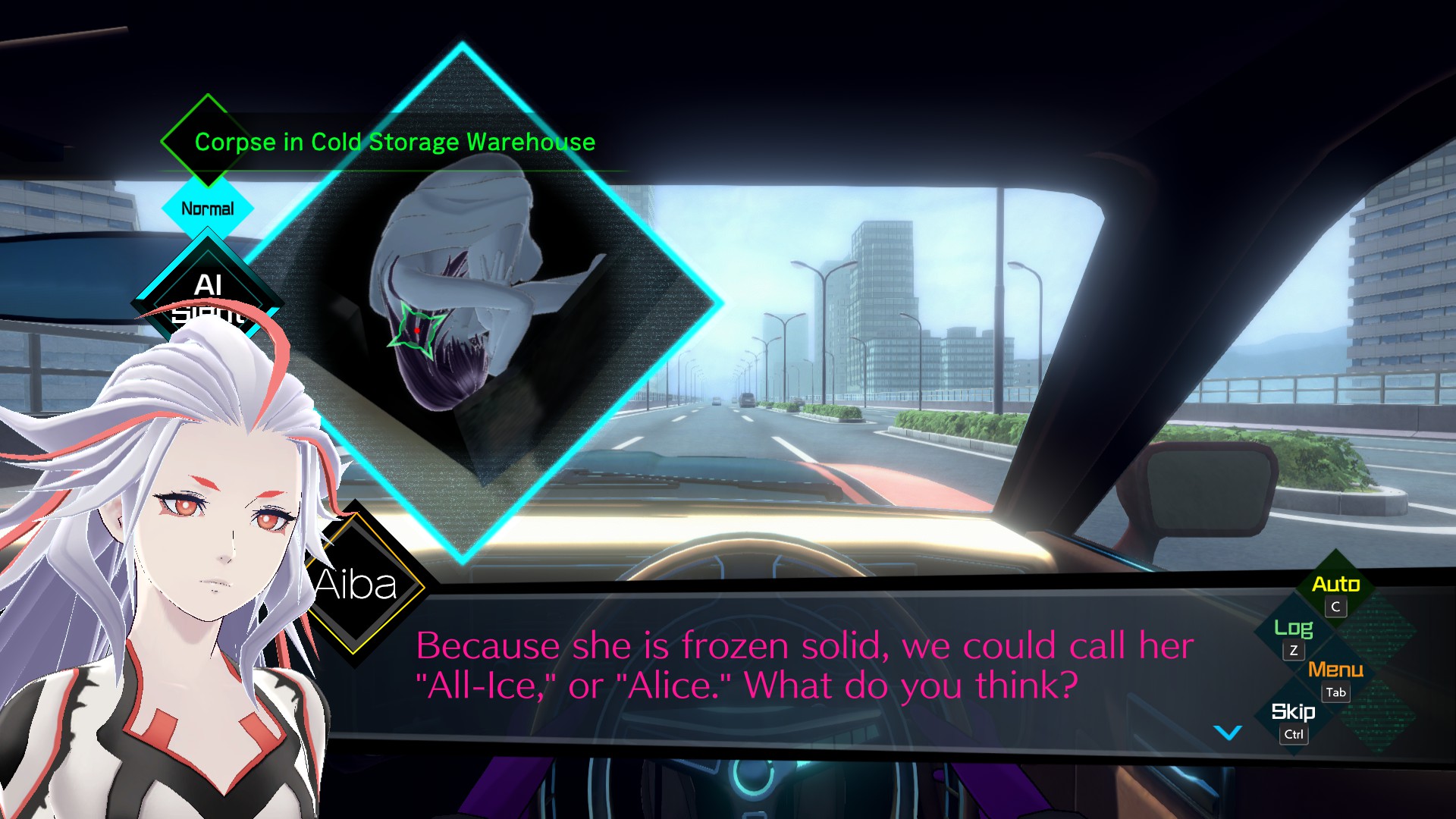
A picture of “Alice’s” (Manaka’s) frozen corpse is shown in the corner. This is a reference to “All-Ice” / “Alice” from Zero Escape.
There are more references to Zero Escape and Spike Chunsoft’s other games within AI, but this one in particular caught me off guard.
Another Code: Recollection #
I had never played Another Code / Trace Memory going in, so I didn’t really know what to expect. I think it was a really fun mystery game.
The first game follows Ashley Mizuki Robins, a 14 year old girl who’s heading to Blood Edward Island in search of her father. She believed her father was dead, but she received a letter from him asking her to come and find him, along with a special device called a DAS (Dual ANOTHER System). In Recollection, the DAS looks strikingly like a Switch despite the fact that it’s 2005 in game. While on Blood Edward Island, Ashley also meets D, a ghost who lost his memories and needs to recover them to pass on. The story focuses on solving these two main mysteries: Ashley’s father, and D’s memories.
The second game (if you can call it that. In Recollection, both games have been smooshed together into one, so there’s no distinct separation between the two besides the timeskip) takes place two years later. Ashley is reunited with her father, but it’s short lived. Ashley’s father moves away again to work at JC Valley, a research company, so they don’t spend much time together. He invites Ashley to come along to a company camping trip at Lake Juliet. At Lake Juliet, Ashley again takes on two mysteries to solve: one to find a boy named Matthew’s missing father, and the other to find the true circumstances behind her mother’s death.
On the second adventure, Ashley gets another part of ANOTHER, this time the RAS, a wristband that Ashley can’t remove. I don’t think that the game ever says what RAS stands for (my guess was Reset ANOTHER System or maybe wRist ANOTHER System). Looking it up, it seems it stands for True ANOTHER System in the European release, and Reboot ANOTHER System in the original Japanese release. This isn’t really related to anything, but I found this tweet that points out the font used on the RAS is the same as the font used in Danganronpa Another Episode. More like Danganronpa ANOTHER Episode, amirite?
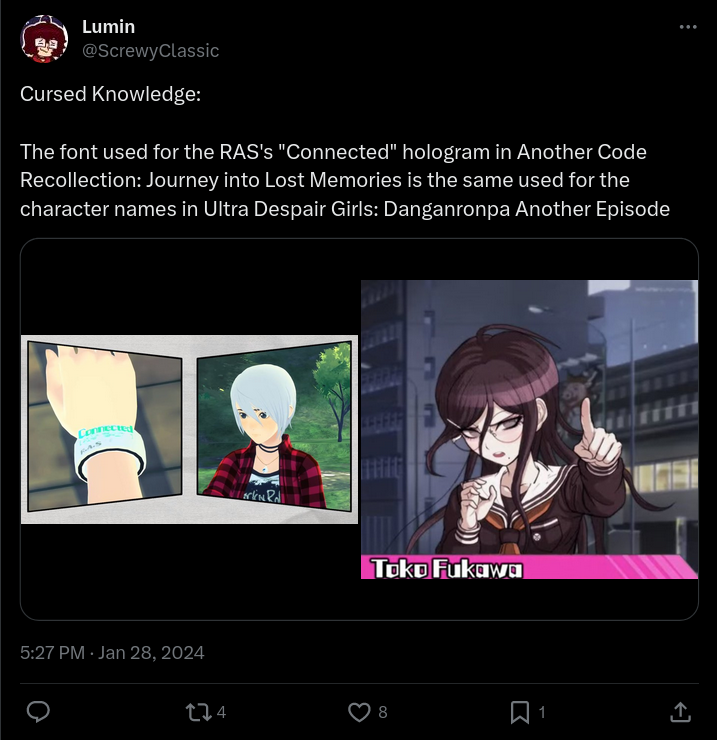
"Cursed Knowledge:
The font used for the RAS's 'Connected' hologram in Another Code Recollection: Journey into Lost Memories is the same used for the character names in Ultra Despair Girls: Danganronpa Another Episode"
Two images are included, one of the RAS from Another Code: Recollection, and one showing Toko Fukawa speaking from Danganronpa Another Episode: Ultra Despair Girls. Both use the same font, as mentioned.
One thing I felt was a little disappointing in Another Code was the puzzles. A lot of them were really simple. There were a couple points in the game where a mechanic is introduced and then seemingly never used again. For example, you can overlay any two photos with the DAS. This is only used in one puzzle. You can overlay two photos at any point in the game, but there is only one point where it’s actually necessary. Another example, the DAS has a front facing camera. You can take a selfie whenever you want, but there is only one place the front facing camera is required. The hint mechanism is nice. Clicking the left stick reveals a yellow waypoint wherever you need to go. It probably makes the game way too easy if you leave it on all the time, but I used it mainly as a way to tell if there’s anything left to do in a room (if you’re finished in a room, the waypoint points to the door).
There is no chapter select, so if you want to get all the collectibles, make sure you do it all in one go or save in multiple slots. Speaking of collectibles, apparently there’s an entire sidequest I mostly missed about trading used cans for gumballs. I only found one can and got one gumball, but apparently there’s a lot of them.
Another Code: Recollection Spoilers, AI: The Somnium Files Spoilers
So, ANOTHER is a device that can rewrite people's memories, right? In the first game, I was a little disappointed that ANOTHER isn't really used for anything. Like, the bad guy, Bill, gets it, he uses it to show that it works (he attempts to trick Ashley's father into thinking he killed his own wife), but we see through it immediately and undo it. I was thinking that it should've been used for *something* more. I figured that I was probably just thinking this because AI: The Somnium Files was fresh in my mind.
But I was proven right in the second game! The ANOTHER is shown to have a secret use: it can swap people's bodies. (Wow, never heard that one before!) Well, it could swap bodies if it worked correctly. Mostly it just kills people when they try. But the villain of the second game, Ryan, tries to use ANOTHER to resurrect Ashley's mother in Ashley's body.
Speaking of Ryan, I don't get why they didn't make him a ghost. Like, he's a sentient liquid memory of the director's dead son who hacked into ANOTHER to project himself into Ashley's mind. But he could have been a ghost! There's a scene where we see security footage where Ashley is supposed to be speaking with Ryan, but Ryan isn't there; only Ashley can see him. My first thought was that he's a ghost: it's already established that Ashley can see ghosts while most others can't. But no, we get an explanation that's somehow more convoluted than him just being a ghost.
Footnotes #
If you don’t know, Portal 1’s crosshair lights up when you’re looking at a portal-able surface and shows an indicator for which portal was placed most recently, whereas Portal 2’s crosshair lights up based on what portals are placed and the indicator for which was placed most recently is on the gun itself. ↩︎
While figuring this out, I noticed that no Source engine games are launching under proton for me. No sourcemods are working either.
 I am uncertain whether this is something Valve broke, or something I broke. Maybe both. I don’t think this is PFT’s fault. ↩︎
I am uncertain whether this is something Valve broke, or something I broke. Maybe both. I don’t think this is PFT’s fault. ↩︎I had to load the levels with the
mapconsole command. Luckily, the maps are given predictable names in the formatch1_002, where the first number is the chapter number and the second is the map number. The only exception to this is the first map in a chapter, which has the formatch1_intro_001. ↩︎I was really disappointed when I heard the AI generated Cave Johnson voice. I don’t get why not just do a (bad) impression. There is a section with real voice acting, and honestly I think it’s a highlight of the game. ↩︎

